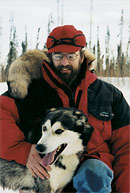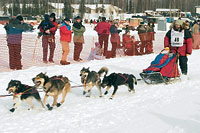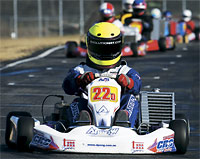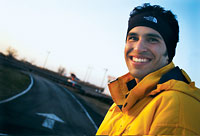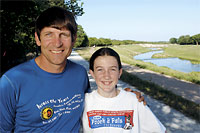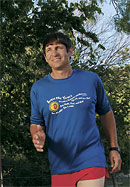 |
|||||||||||||||||

Eagles on the Go |
Researchers say that eagles in the wild fly between 60 and 100 miles an hour at heights of 2,500 to 5,000 feet. Three members of the UNT family — two alumni and a junior marketing major — are doing some soaring of their own in the fields of sled dog racing, kart racing and ultramarathons. Randy Cummins:
Randy Cummins (’82) remembers when he first fell in love — with sled dog racing. It was on a visit to Alaska in 2001. At the time, he was a doctor in the Spokane, Wash., area. Cummins saw the beginning of the Iditarod sled dog race and knew he wanted to take part. “I was hooked,” Cummins says. He began mushing the next year and sold his practice in 2003 to move to Alaska. In March of this year, Cummins competed in the 2006 Iditarod along with sled dogs from his Huskytown kennel. “I started the kennel with just three or four dogs, and then decided to get more,” Cummins says. “Once I had eight or nine dogs, I thought I should get involved in racing.” Cummins was planning to run in last year’s Iditarod, but he dropped out before the competition began. “I made some mistakes, and we weren’t as ready last year,” he says. To prepare for this year’s race, he took his sled dogs out for training and qualifying runs, and the dogs had between 1,700 and 2,000 miles of racing experience before they hit the Iditarod starting line. This year’s 1,150-mile race began in Anchorage on March 5. Fifteen days, 11 hours, 46 minutes and 45 seconds later, Cummins and his sled dogs crossed the finish line in Nome. That was good enough for 66th place out of 83 mushers. Cummins says the course was “very windy” and notes he broke a runner on his sled, which he was able to replace after 60 miles of poor steering. He also faced temperatures of 20 to 30 degrees below zero and overcame several crashes, including one that required spending the night in a ravine and chopping through brush to get back to the trail.
“The dogs did very well — stayed healthy, eager and happy — and as long as they were doing well, I had no reason to quit,” Cummins says. “But not until I saw the sign that said ‘Nome 20 miles’ was I sure I was going to finish.” Cummins is already looking forward to competing in the 2007 Iditarod. “I’ll know much better how to handle the challenges on different sections of the trail next year,” he says. “I’d like to improve my time by three days. And it’s a remarkable way to see Alaska.”
Michael Johnson: Junior marketing major Michael Johnson’s dream job isn’t in a corner office. It’s in the cockpit of a Formula One racing car. Johnson says he may be able to achieve that goal in four or five years. Johnson’s family has racing in its blood — his father was an amateur racer. By the time Johnson was 12 years old he was racing too. “I thought it was a neat thing to do,” he says. So far, Johnson has won five national kart championships. He was also a member of the 2005 U.S. Kart racing team that competed in the world finals in the Canary Islands. Johnson finished 13th out of 78 drivers. He also gets to drive a Formula racing car once a month, on average. Johnson is currently in the midst of a three-year contract with O’Brien Racing of Dallas as the lead pilot of its Formula Atlantic team. He competes in about two kart races a month and works part time as a race driving instructor at Texas Driving Experience at Texas Motor Speedway. Preparing for a race is a full-time job, according to Johnson. “Racing is very demanding,” he says. “You have to do physical conditioning all year long. The weeks before an event involve working with the mechanics and engineers, adjusting the vehicle and getting it ready. Then, when it comes time to race, the car is perfect and you are ready to go, and you can focus totally on winning.”
Johnson says it’s a challenge balancing school and his burgeoning race career. “It’s all about organization. School is my No. 1 priority, but I do try to balance it with racing,” he says. When Johnson graduates from UNT, he plans to move to Europe to pursue racing full time. “I want to spend a few years of lower-ranked Formula racing in Europe, because it’s very competitive,” he says. “With two or three years of experience at that level, I will be ready for Formula One.” Money will be a major factor in Johnson’s racing future. He chose marketing because racing is dependent on sponsorships and promotion. “A junior Formula racecar is $100,000 and a racer will need about $500,000 in sponsorships to be competitive,” he explains. “IRL racer Danica Patrick is a good example. She came up through the ranks, but one of the big reasons for her current success is because she is very marketable and has sponsors’ money behind her.” Johnson is confident about his future as a racer. “I’ve had a lot of success as a kart racer so far, and I am looking ahead to carrying that momentum to Formula One,” he says.
Tony Mathison: Six years ago, Tony Mathison (’87 M.Ed.) was 41. He had run marathons for years. He thought he was in good shape. But there was one race he wasn’t able to compete in — the Boston Marathon. Mathison’s best marathon time wasn’t low enough for his age group to qualify for the race. “I reached a point where the Boston Marathon’s demanding training was not realistic, and it led me to think what I could do instead. So, I thought I could run longer than the distance of a marathon. It’s all about endurance,” Mathison says. That decision led Mathison to the sport of ultrarunning, which involves races of any distance longer than that of a marathon. Typical races are from roughly 30 to 100 miles and can be run over several hours or days. Mathison ran in his first ultrarunning event in March 2002. It was the Grasslands 50-mile race, held on the LBJ National Grasslands north of Decatur. It was also a stormy day. “Two sweepers (people on horseback watching out for runners) stayed with me while I was out there, in spite of the thunder and lightning. That made me think this was a special hobby with special people,” he says. Mathison teaches special education math and is a junior high cross country coach in Bangs, south of Abilene. He says students have mixed opinions when they find out about his hobby.
“Quite a few of them are in disbelief. Some of my best athletes connect with the hard work it takes to compete like this, and it serves as an inspiration. Others can’t fathom running distances like this,” Mathison says. “It’s really only noticeable to those athletes who already have good training habits.” Ultrarunning is now a family affair for Mathison. His 11-year-old daughter, Cayla, has also taken up the hobby. In January, father and daughter competed in a 72-hour run in Arizona. “You don’t run for the full 72 hours, though,” Mathison says. “I made sure Cayla slept, ate and drank while she competed.” Mathison has competed in four ultrarunning races since 2003 — three races of 100 miles and a fourth of 140 miles. Currently, he is working to qualify for the Western States 100-mile run, to be held near Sacramento, Calif., next summer. “You have to apply and qualify for it one year, and if you do that, you can race the following year. That is my goal,” he says.
|
||||||||||||||||||||||||||||||||||||||||||||||||||||||||||||||||||||||||||||
